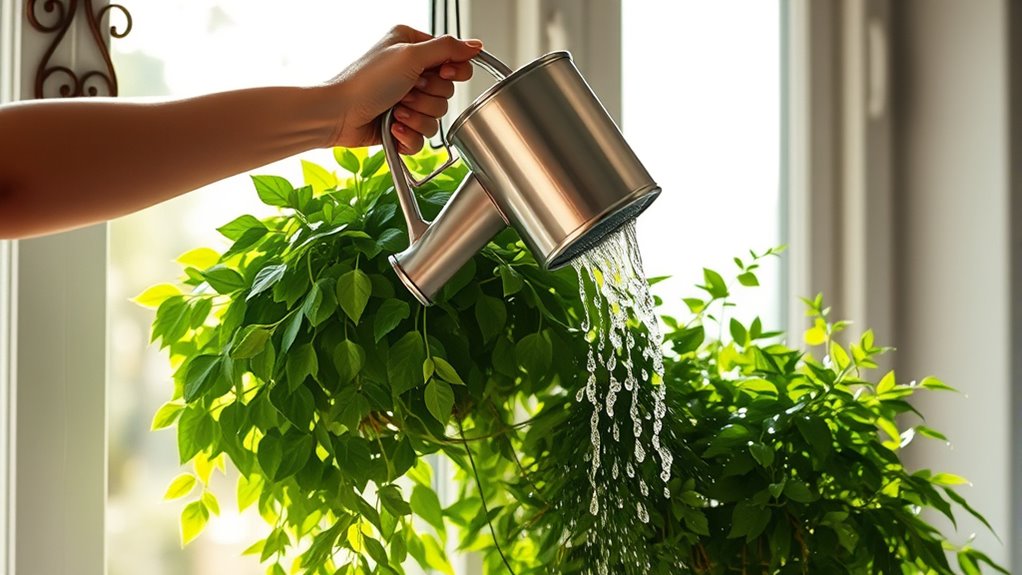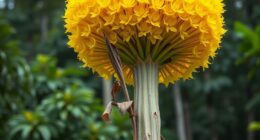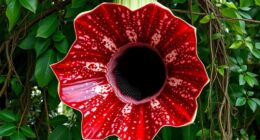When watering indoor hanging plants, check the top inch of soil first; only water if it feels dry. Use a long-spout watering can for easy access, and consider bottom watering for even moisture. Adjust watering frequency with the seasons, increasing from March to September. Watch for signs of overwatering, like drooping leaves. Good drainage is crucial to prevent root rot. To keep your plants thriving, explore innovative techniques and pot selections that suit your space.
Key Takeaways
- Use a long-spout watering can or extendable wand to reach hanging plants easily without spilling water.
- Check soil moisture by inserting your finger; water only when the top inch feels dry.
- Water thoroughly until drainage occurs; ensure pots have drainage holes to prevent waterlogging.
- Consider bottom watering by placing the pot in a saucer of water to absorb moisture gradually.
- Monitor for signs of overwatering, like drooping or yellowing leaves, and adjust watering frequency accordingly.
Understanding the Water Needs of Hanging Plants

When you care for hanging plants, understanding their water needs is crucial for their health. Light exposure, temperature, and humidity play significant roles in determining how often you should water. If your plants hang near bright windows, they may dry out faster, requiring more frequent watering. Higher temperatures or low humidity levels also increase water loss, so keep an eye on those conditions. Assess soil and pot conditions too; well-draining soils and terracotta pots dry out quicker than dense soils and plastic pots. Additionally, keep in mind that plants prefer deep watering over frequent shallow watering, which can promote healthier root systems. Implementing efficient storage strategies for your gardening supplies can also make it easier to care for your plants and maintain their health.
Using high-quality soil can further enhance moisture retention and overall plant health. Remember, seasonal changes affect watering frequency; you’ll need more water in summer and less in winter. Always check soil moisture by sticking your finger in to ensure your plants get just the right amount. Furthermore, understanding the impact of seasonal trends on plant growth can help you adjust your care routine throughout the year.
Choosing the Right Watering Technique
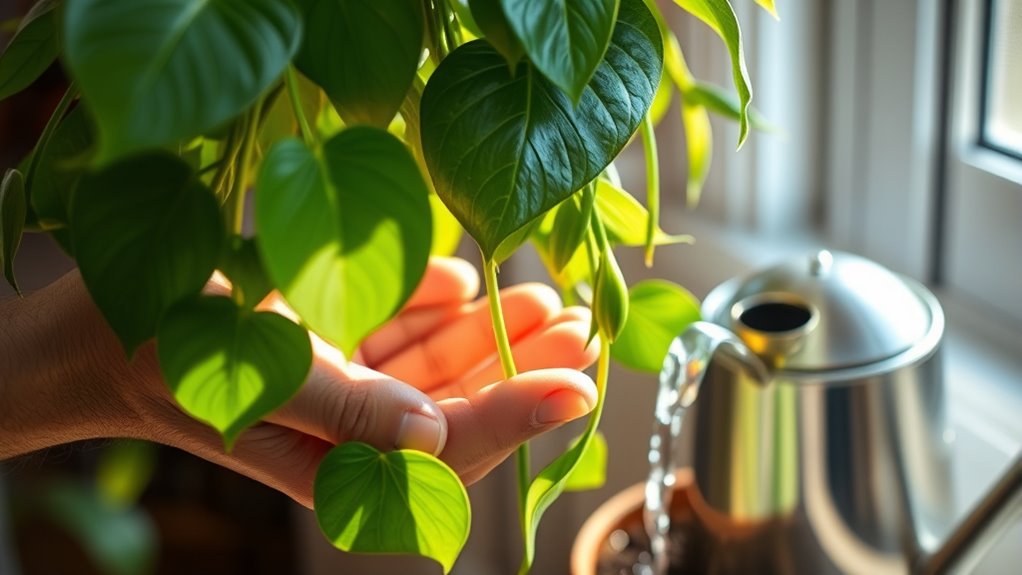
Understanding your hanging plants’ water needs sets the stage for selecting the best watering technique.
Recognizing your hanging plants’ water requirements is essential for choosing the most effective watering method.
You can choose top watering, where you pour water directly onto the soil until it drains out, or bottom watering, which allows the plant to absorb moisture from a saucer underneath. National parks often provide inspiration for indoor plant arrangements due to their diverse ecosystems, encouraging creativity in your home.
If you prefer a cleaner method, consider using ice cubes that melt gradually or capillary action with a cloth strip to maintain consistent moisture. Hanging plants often benefit from self-watering systems, which help manage moisture levels automatically. Additionally, it’s crucial to check soil moisture regularly to determine when your plants need watering. Just like how dogs require moderation in their diet, consistency in watering is essential for optimal plant health.
When watering, use a narrow spout watering can to target the base without splashing.
Always monitor the soil’s moisture to avoid overwatering, ensuring your plants thrive and stay healthy.
Accessibility and Maintenance of Hanging Plants
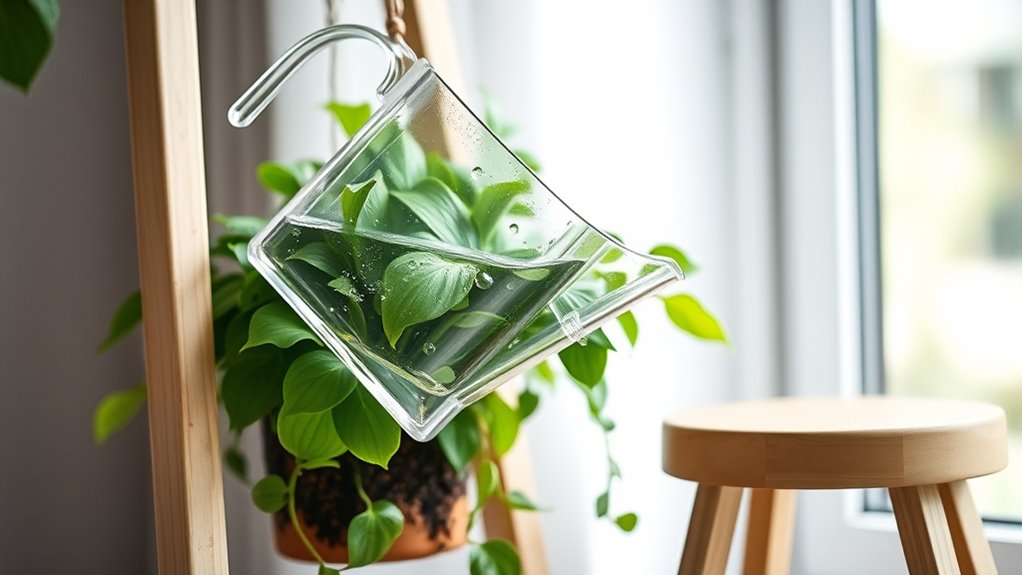
How can you ensure your hanging plants thrive while remaining accessible for care? Start by selecting the right plants that match the light conditions of your space. Trailing plants like pothos or philodendrons work well in various light. Additionally, consider the light levels in your home when choosing plants to ensure they receive the right amount of brightness for optimal growth. Incorporating cozy textiles in your plant area can enhance the overall ambiance, making it a more inviting space. Providing educational toys can stimulate creativity and problem-solving skills in children, much like how nurturing plants can encourage responsibility and care. Furthermore, incorporating gentle methods in your plant care routine can enhance your emotional connection to your greenery.
Use strong hooks and brackets to support the weight of your plants and soil. For easy watering, consider long-spout cans or extendable wands. If you have several hanging plants, a pulley system can make maintenance a breeze.
Don’t forget to inspect your plants regularly for stress, deadhead flowers, and prune as needed to promote healthy growth. Additionally, top up the soil with organic matter to keep nutrients balanced, ensuring your plants flourish in their hanging environment.
Innovative Watering Methods for Efficient Hydration

Ensuring your hanging plants receive the right amount of water can be a game changer in their care routine. Try the capillary action method, where a cotton strip draws water from a container to the soil, keeping it consistently moist. The ice cube method works well for low-maintenance plants, providing slow hydration. Bottom watering allows plants to absorb moisture from the roots up, preventing dry spots. For a high-tech approach, consider smart self-watering systems with built-in reservoirs, which operate similarly to self-watering plant pots. Cache plates are another effective way to collect excess water while keeping your plants stylishly displayed. Wick watering, using a cotton rope, transfers water effectively from a vase to the soil. Additionally, using consistent moisture is crucial for the health of your plants, as it helps prevent stress and promotes growth. Understanding the importance of advance directives can also guide your overall care planning, ensuring that you are prepared for any unexpected circumstances. Experiment with these innovative techniques to find what suits your plants best, ensuring they thrive and flourish in your indoor space.
Preventing Overwatering and Root Rot
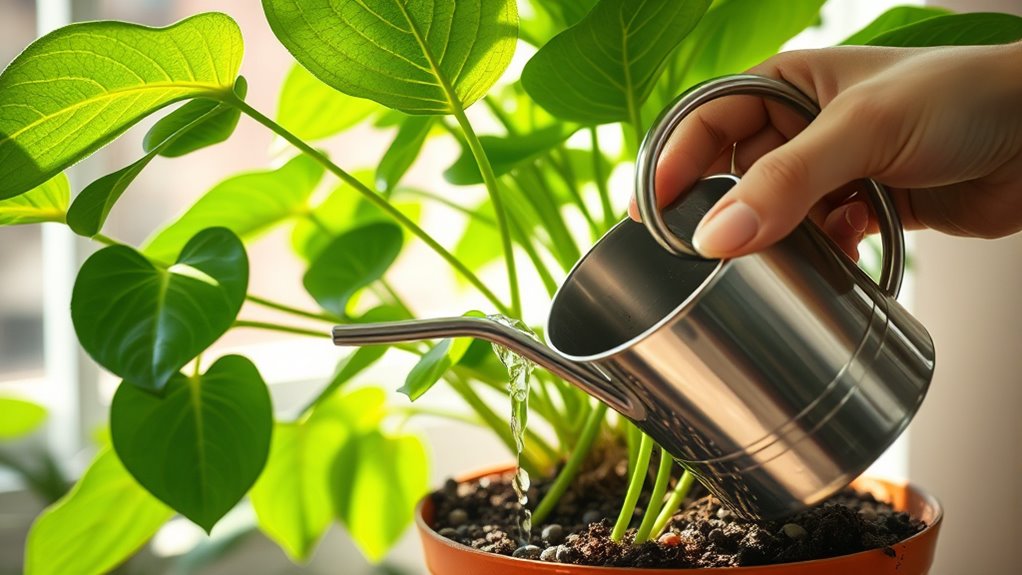
While caring for indoor hanging plants, preventing overwatering and root rot is crucial for their health and longevity.
Start by checking the soil moisture; insert your finger up to the first knuckle. If it feels dry, it’s time to water. Avoid strict watering schedules; instead, adjust based on your plant’s needs and seasonal changes. Additionally, ensuring proper airflow around the plant can help reduce the risk of root rot. Using essential oils such as lavender can also improve the overall health of your indoor plants by promoting a balanced environment. Incorporating ethical hacking principles can also guide you in identifying potential issues with your plant care routine.
Use pots with drainage holes to prevent water pooling and choose well-draining soil. Always monitor your plant’s appearance—drooping or yellowing leaves can signal overwatering.
Lastly, select the right pot size and material; terra-cotta pots dry out faster than plastic ones. By following these tips, you’ll keep your plants thriving and healthy.
Managing Mineral Buildup in Soil

As you care for your indoor hanging plants, managing mineral buildup in the soil is essential to their health. Mineral accumulation often happens due to dissolved salts from water and fertilizers. You’ll notice signs like white or yellow crusts on the soil or around pot edges, yellow or brown leaves, and reduced growth. To combat this, leach the soil every 4-6 months by thoroughly watering until it drains out. Regular cleaning is also crucial for maintaining the health of your plants, as dust and debris can affect light absorption. Use filtered or rainwater to minimize mineral intake, and avoid overfertilizing. Ensure good drainage to prevent waterlogging, which can worsen the problem. High salt levels can hinder water uptake, leading to further stress on your plants. Additionally, incorporating chia seeds’ nutritional benefits into your diet can help support your overall plant care routine, as a healthy gardener is more attentive to their plants’ needs. Diversification of retirement portfolio is similarly important in managing financial health, and just as you monitor your plants for stress signs, regularly inspect your plants for stress signs and adjust your care routine accordingly to keep them thriving.
Seasonal Adjustments for Watering Frequency
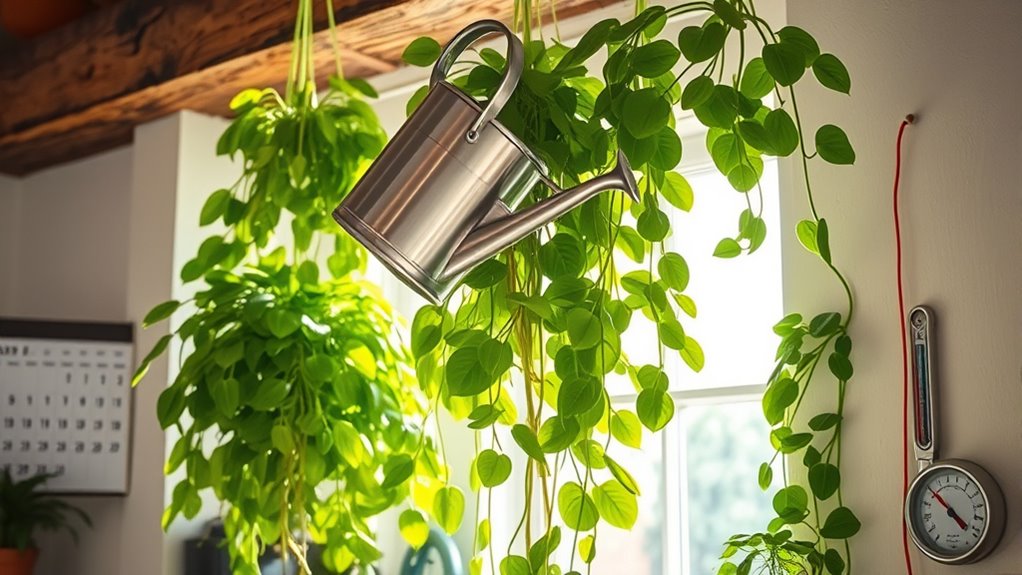
Managing mineral buildup in the soil helps create a strong foundation for your indoor hanging plants, but watering frequency is just as important to their overall health.
From March through September, your plants grow more rapidly, so you’ll need to increase watering during this active growth period. Incorporating natural elements like soil amendments can further enhance their growth. Additionally, utilizing low light office plants can help improve air quality around your hanging plants. Conversely, from October through February, their growth slows, and you should reduce watering to match their dormant state. Additionally, it’s crucial to monitor soil moisture regularly to prevent underwatering and overwatering during these seasonal changes. Implementing effective home improvement strategies can also enhance the living conditions for your plants.
Remember, environmental factors like temperature and humidity also play a role; warmer rooms and dry air, especially in winter, require more frequent attention.
Adjust your watering based on specific plant needs, light exposure, and pot size—these elements will ensure your hanging plants thrive throughout the seasons.
Organizing Your Plant Care Routine
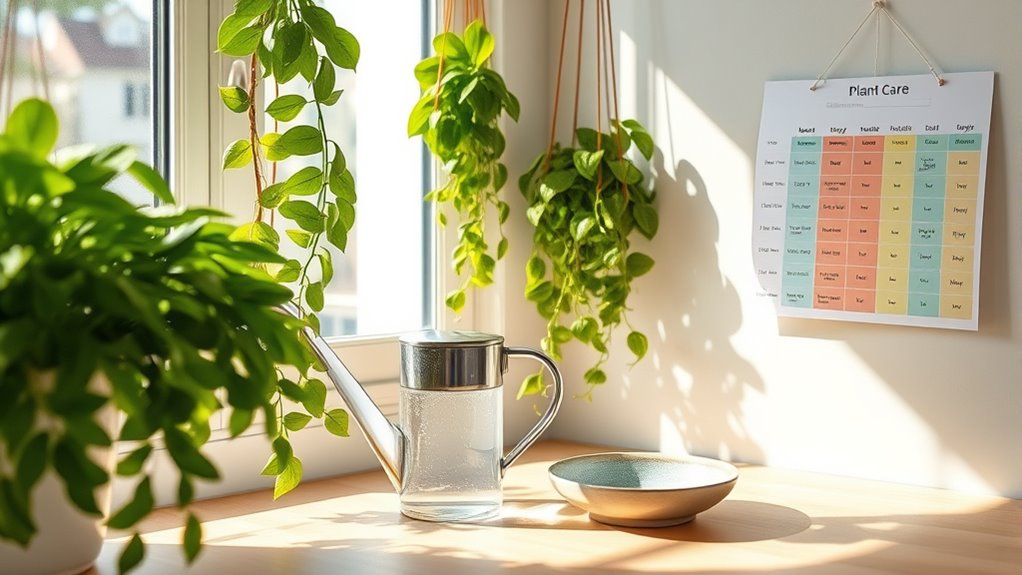
To keep your indoor hanging plants thriving, it’s essential to create a structured plant care routine.
Start by selecting plants that suit your space, like ferns or spider plants, and ensure they’ve similar light requirements. Place your plants near windows or use grow lights for those in low-light areas, being mindful to avoid direct sun exposure on sensitive varieties. Many indoor plants thrive in well-drained soil, which helps prevent root rot and promotes healthy growth. Additionally, maintaining indoor air quality can contribute to the overall health of your plants.
For watering, use a squeeze bottle or mister, checking the soil moisture regularly to water only when the top inch feels dry. Ensure you use high-quality soil for optimal growth and moisture retention.
Don’t forget to fertilize weekly during growth seasons and inspect your plants for pests. Regular maintenance and attention to their needs will help your indoor hanging plants flourish in your home.
Selecting the Best Pots and Drainage Systems
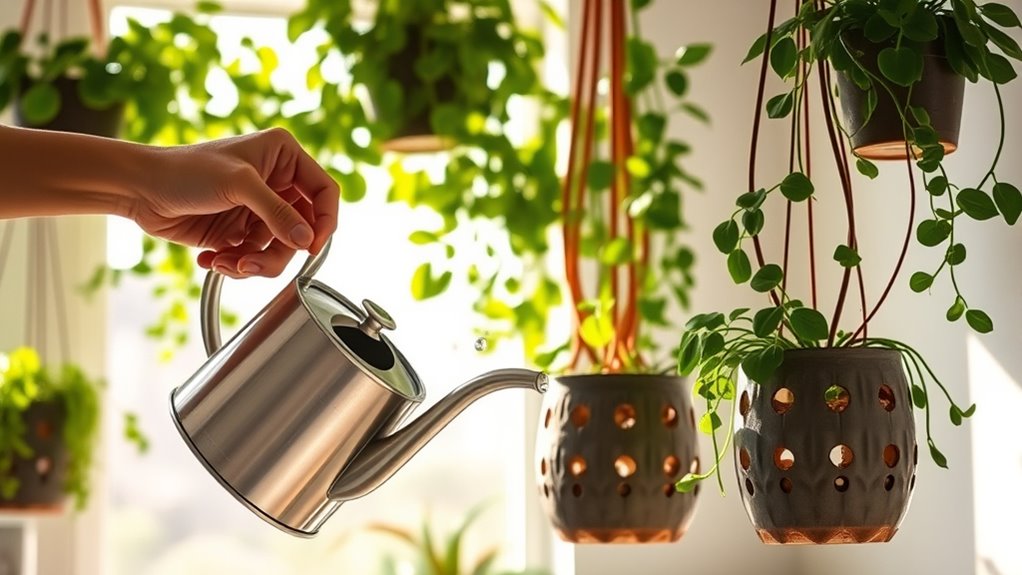
Selecting the right pots and drainage systems plays a key role in the health of your indoor hanging plants. Choose between materials like ceramic for insulation, lightweight plastic for easy handling, or terracotta for excellent air circulation. Ensure your pots have drainage holes to prevent waterlogging, and consider using a well-draining potting soil mix. If your pots lack drainage, decorative liners can help with moisture control. For larger plants, opt for pots that accommodate their mature size and provide enough soil volume. Don’t forget aesthetics—select pots that complement your plant’s foliage. Lastly, if you’re using heavier pots, ensure they’re properly supported to prevent accidents. Proper pot selection makes a significant difference in your plant care routine, especially for plants like the Pothos, which thrive in various light conditions.
Monitoring Plant Health for Optimal Growth

While nurturing your indoor hanging plants, monitoring their health is essential for fostering optimal growth.
Start by checking soil moisture using sensors or the finger test; if it feels dry an inch down, it’s time to water. Adjust your watering frequency based on plant type and seasonal changes. Ensure your plants receive the right light by using light sensors, placing them near windows with indirect sunlight, or employing grow lights in darker areas. Additionally, be mindful of common issues like overwatering or insufficient light, as they can significantly affect plant health. Keep an eye on temperature and humidity levels, using sensors and misting as needed.
Regularly inspect for pests, treating infestations promptly with neem oil. Lastly, maintain plant health through balanced fertilization and regular pruning to encourage bushy growth.
Frequently Asked Questions
Can I Use Tap Water for My Indoor Hanging Plants?
You can use tap water for your indoor hanging plants, but be cautious.
Tap water often contains chlorine, fluoride, and hard minerals that can harm sensitive plants. If you notice leaf burn or poor growth, consider alternatives like rainwater or filtered water.
Testing the pH and quality of your tap water can help you make informed decisions.
Ultimately, paying attention to your plants’ responses will guide you in choosing the best watering method.
How Do I Know if My Hanging Plant Needs Water?
Think of your hanging plant as a thirsty friend; it’ll let you know when it’s parched.
Check the weight of the basket; if it feels light, it’s time to water.
Stick your finger into the soil—if it’s dry 1-2 inches down, your plant needs a drink.
Also, keep an eye out for wilting leaves.
What Common Signs Indicate Overwatering in Hanging Plants?
If you notice wilting leaves despite moist soil, your hanging plants might be overwatered.
Yellowing or browning leaves are also signs, along with soft, limp foliage.
Check for rotten stems and the presence of fungus gnats; these indicate excess moisture.
If the soil remains consistently wet or feels compacted, it’s likely causing root rot.
Pay attention to your plant’s stability and growth, as these factors can signal overwatering issues too.
Are There Specific Plants Better Suited for Hanging Arrangements?
Hanging plants can transform your space into a lush paradise! For stunning arrangements, consider hoya, pothos, or spider plants.
Hoya’s waxy leaves shine in bright, indirect light, while pothos adapts to various conditions with ease. Spider plants dangle gracefully, thriving when slightly moist.
If you’re looking for a fast grower, try Tradescantia White Inch, or for something unique, the succulent String of Pearls offers a striking look.
Each brings charm to your indoor oasis!
How Often Should I Fertilize My Hanging Plants?
You should fertilize your hanging plants every 7 to 10 days during their growing season.
This regular feeding helps them thrive, especially in spring and summer when they’re actively growing.
If you’ve got new plants, they might need more frequent applications since they’re heavy feeders.
Just remember to adjust based on their specific needs and the environmental conditions.
Keeping soil moisture in check is also key for effective fertilization.
Conclusion
In conclusion, taking care of your indoor hanging plants can be a delightful journey. By understanding their unique water needs and experimenting with different techniques, you’ll discover what works best for you and your plants. Just like finding the perfect spot for a favorite photo, nurturing your greenery brings a sense of joy and satisfaction. So, grab that watering can, adjust your routine, and watch your hanging plants thrive, creating a beautiful, green oasis in your home.

